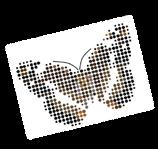From the editor
Well, what a busy lot you have been. Some great articles from you all and something new for members, field trips! Yes, page 28-29 has all the details and gives all of our members the opportunity to get out there with like minded people to go out and enjoy what naturalists enjoy the most, exploring nature. If it is successful and has a good turn out, we will have more in the future.

Summer is trying to get underway and as I write this, I’m currently under a blanket trying to keep warm. Hopefully, warmer weather is not far away, especially for our field trips.
Our Facebook members’ page is proving to be quite successful with lots of wonderful photos from our members of the amazing wildlife they’ve seen. If you haven ’t joined the page yet and would like to get involved, then just drop me an email and I will send you a link to join.
For those of you who could not make it to our spring members ’ meeting in April, there’s a nice write up by Gen on p.34. There have also been some changes with the council and it has all been nicely summarised by our new Chair Joan Hardingham on p20.
The next deadline for the newsletter will be 30th September, so please show us what you’ve been up to over the summer and don’t forget to include photos too.
That said, I hope you all have an enjoyable summer, lets hope it doesn ’t get too hot though.
All the best. Editor
White Admiral 112 2
Hawk Honey
Felix Cottage Athelington Rd, Horham, IP21 5EG
1
whiteadmiralnewsletter@gmail.com
Early morning walks can often bring you close to the unexpected! It was one morning in late February that I had one such encounter. For those who know Flatford, you are probably aware of the lake beyond Willy Lott’s House. Part of a much larger Gibbonsgate Field, a significant area, now the lake, was excavated for gravel in the mideighties when for a few months big lorries rushed past Flatford Mill, empty coming down and loaded going up, shrouding everything in dust!
But it created a beautifully quiet lake. Over time, the shores became self -colonized by willows and alders and the slopes thickly bordered by a belt of small trees and shrubs. A unique habitat for both water and shrub/woodland birds and many things besides. Erected by the National Trust, the lake also boasts a couple of bird hides, excellent for bird-watching. However, this little story is about something other than birds!

It was around 8 on the morning of Saturday 26 February that I heard some enthusiastic splashing on my right but I couldn ’t see much through the thick layer of shrubs and trees. I was on the circular path on Rasik Bhadresa
White Admiral 112 3
the east side of Gibbonsgate Lake (TM079329). But it was when I turned right to make my way to the Longhurst Hide that I saw three bobbing heads amongst a sea of waves they were creating. Surely not dogs! But as I went into the hide for an unobstructed view and looked through the cinemascopic slot, right away the penny dropped. Otters! Amazing!
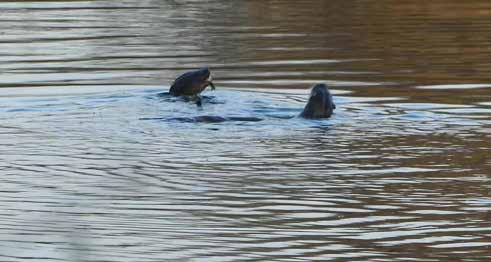
There were three, two slightly larger (possibly males) and one a little smaller. But they were very busy, continuously plunging and disappearing only to resurface with fish between their carnivorous teeth.

White Admiral 112 4
They didn’t waste much time devouring their personal catch. With the fur wet, dark, smooth and glossy, these terrier -sized carnivores, also aptly known as water-dogs, looked quite large with the long fleshy tails lashing the surface waters as they dived.
What surprised me was that each dive generated a sea of bubbles both as a result of air escaping from the nostrils and mouth but also which may have got trapped in the fur. As I watched, they gradually moved away northwards but still continuing to heave, plunge and resurface, raising their heads to deal with the caught fish. As they neared the edge of the lake at the far end, their behaviour changed, now only their heads showing above the water as they swam towards their temporary (their territories can easily range over 10 miles!) destination, the overgrown bank, and soon out of sight. But the encounter with this raft of otters will forever remain imprinted in my mind!
Nice to know we share the same world.
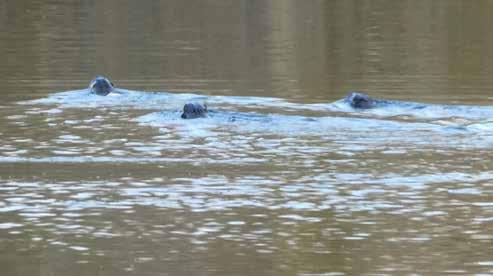
If you’ve had an amazing encounter, please share it with us. Email us a Word document with separate photos and I’ll do the rest.
whiteadmiralnewsletter@gmail.com
White Admiral 112 5
Pamela Pope
As a lifelong arachnophobe, I have always been fascinated, albeit wary of spiders. Seeing the colourful orb -web spiders of South America and Asia was the turning point, where my fascination started to overcome my fear. My first glimpse of a wasp spider Argiope bruennichi was in a tank at the Bird Fair, and when I first saw one in the wild at Lakenheath Fen I was thrilled.
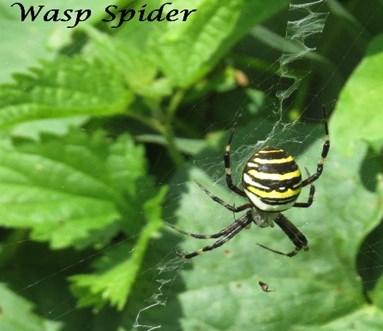
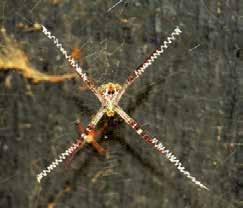
The wasp spider (4 – 15 mm) occurs in low vegetation. The main food source being grasshoppers. If the spider is not visible the tell-tale vertical silk zigzagging of the web is easy to spot. The colourful aptly named Signature spider of India has a more distinctive zigzag pattern in its web.
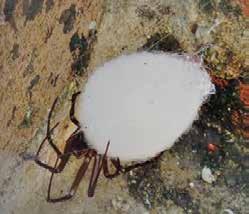
A spider that you may see quite commonly in East Anglia, living in conditions of total darkness is the Cave spider. There are 2 British species, Meta menardi and M. bourneti.
I found my first when the manhole in our garden was lifted. They produce a large white egg-sac which they suspend from the roof of the habitat.
White Admiral 112 6
Wasp spider A. bruennichi Signature spider A.anasuja

Both species are large and glossy with long legs. Microscopic examination of the genitalia is needed to confirm the identification of the species.
Left and previous page bottom: Cave spiders Metaspecies
When I was wandering around our local community woodland in Lawshall this year I spotted the colourful orbweb spider Araneus marmoreus var. pyramidatus. The spider is very distinctive, having a reddish brown wedge -like marking in the middle of a bright yellow abdomen. This species is considered to be uncommon, but widespread throughout


south-east England. It is found in damp woodland and heathland on tall plants and on the lower branches of trees.
The garden spider Araneus diadematus is the best known of the orb-web spiders, and one of our largest spiders. It is usually seen between June and November in a wide range of habitats. It can be very variable in appearance but the cross-like pattern of pale spots and markings is usually present on its anterior surface. They usually sit in the middle of the web waiting for the vibrations of a struggling insect.
White Admiral 112 7
Araneus marmoreus var. pyramidatus.
R


Another spider in this group is A. quadratus, The Four-spotted Orb-web spider. These spiders tend to occur in undisturbed herbaceous vegetation and shrubs such as sedges and heather and gorse. It needs to be able to support a large web up to 40 cms.
Crab spiders, family Thomisidae are a slow-moving small group of spiders (size 2 -11mm) that tend to be found

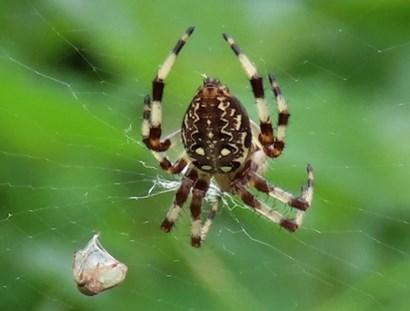
in low vegetation and flower heads. They are broad-bodied eight-eyed spiders. The front legs are longer and stouter than the others and turn forwards giving a crab like appearance and an ability to walk sideways. Xysticus cristatus (3-8 mm) is one of the commonest crab spiders, occurring in low vegetation in almost every habitat type except woodland as it is intolerant of shade.
White Admiral 112 8
Crab spider X.cristatus
The Four-spotted Orb-web spider Aquadratus
Left: Ventral view of Garden spider.
Right: Garden spider with prey.
Steatoda nobilis is the largest of the British Steatoda sp, found around house and out buildings. It is an introduced species and considered to be one of the world’s most invasive species of spider. It has a lifespan of up to five years. Females have been known to bite but only in response to threat or disturbance.
The Noble False Widow spider is more active at night where it sits at the entrance to its web. Sensationalised stories have appeared in newspaper articles, but the severity of a bite/sting appears to be comparable to that of a wasp, and less likely. Recently featured on ‘Winterwatch’, they are now known to be able to catch and eat pipistrelle bats!


The common candy-striped spider Enoplognatha ovata is particularly attractive. It is a small spider about 6 mm from head to tip of abdomen, and it has two red longitudinal bands. The photograph left, is form redimita. This can be found from May to October in most gardens. It feeds on small insects and belongs to the group of comb-footed spiders (family Theridiidae).
One of Suffolk’s most famous spider residents is the Fen Raft Spider. This has been brought back from near extinction at Redgrave & Lopham Fen, by captive breeding and relocation projects. It is now thriving at Castle Marshes, and Carlton & Oulton Marshes.
Fen raft spiders, Dolomedes plantarius, are one of the UK’s largest and rarest spiders. They walk on the water hunting prey which can include amphibians and even small fish.
White Admiral 112 9
The Noble False Widow spider S. nobilis 7-11mm
Common Candy-stripe spider E. ovata
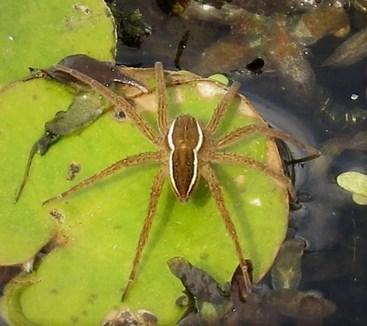
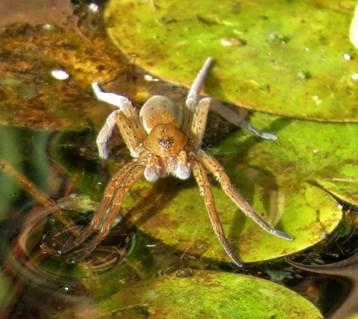
The spider sits on vegetation in the water with its forelegs resting on the water surface where it can detect vibrations created by prey. It can also go underwater to hunt or if threatened.
There are five British species of cucumber spiders, belonging to the genus Araniella. These will be seen particularly on hedgerows and in woodland, although the size of just 4- 6 mm means that it is often overlooked. Microscopic examination is required to separate most species.
They spin a small web between leaves and don't hide away but rely on colour for camouflage. They are predatory mainly on flying insects caught in its orb web.
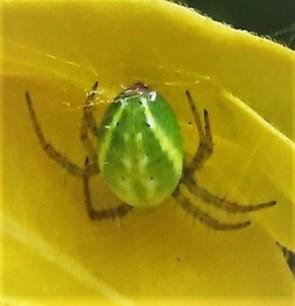
Top left and right: Fen raft spider Dolomedesplantarius.
Left: Cucumber spider Araniellasp.
Acknowledgement:
Britian’s Spiders - A field guide Lawrence Bee, Geoff Oxford and Helen Smith.
White Admiral 112 1 0
Anna Saltmarsh
In 1020, in the settlement then known as Beodricsworth, the first stones were laid of a Benedictine monastery in the location which had come to house the bodily remains of Edmund, King of the Anglo -Saxons. One thousand years later, in 2020, and the settlement now familiar as Bury St. Edmunds was preparing to celebrate the anniversary of the founding of the great Abbey which stood, for centuries, among the most powerful in England.
The Abbey of St. Edmundsbury was eventually dissolved in 1539 during the Reformation, but ruins of the mighty Abbey church, and other significant features and buildings, remain as landmarks in the centre of Bury town. Flint walls still mark some boundaries of the Abbey precinct, for example around the Abbey Gardens and along the edge of the carpark neighbouring the Great Churchyard. Land associated with the monastery, nestled between the rivers Lark and Linnet, and once used for raising fish stocks (the Crankles) and as riverside grazing meadows (No Mans Meadows), are now managed as local nature reserves with the help of volunteer members of the Bury Water Meadows Group (BWMG).
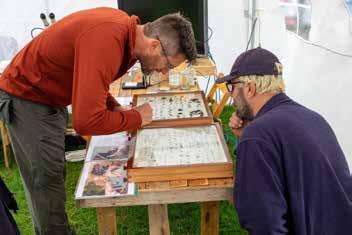
Entomologist Dr Ross Piper and Suffolk Wildlife Trust’s Hawk Honey were on hand throughout the day. © Chris Cross
The Abbey 1000 celebrations, like so many other things, were postponed due to the restrictions resulting from the Covid pandemic but finally came to fruition in 2022. Among these was a two-day celebration of the wild diversity that can currently be found occupying the Abbey precinct and nearby town centre water meadows – the 2022 Bury BioBlitz.
White Admiral 112 1 1
On Friday 20th May pupils from three local schools –Guildhall Feoffment, Westley Middle and Priory –were welcomed to the BioBlitz hub located beside the Lark Bridge in the Abbey Gardens. The drought which characterised the summer of 2022 was not evident on that first day so all participants were very grateful for the tents and marquees loaned for the event and erected by BWMG volunteers. Between showers, students were introduced to techniques such as sweep -netting for invertebrates, plant surveying and measuring the vital statistics (height and girth) of specimen trees in the Abbey Gardens. Meanwhile, under the shelter of canvas, West Suffolk Hive volunteers demonstrated and supervised the transformation of leaves and flowers into works of art through the Japanese craft of Hapa Zome.

In the late evening of Friday 20th two light -traps were set up in the Abbey Gardens coinciding with UK moth night. The weather conditions – cool and windy – resulted in a very limited catch. Among the few species recorded were Flame (Axylia putris) and Treble Lines (Charanyca trigrammica ) moths and a caddis fly (Mystacides azurea
Saturday 21st May began with a popular early morning bird walk launching a public event including a series of free themed walks scheduled throughout the day. Those who rose – and booked were rewarded to songs and sightings including those of Reed Bunting (Emberiza scheoniclus), Whitethroat (Sylvia communis) and, very appropriately given the location, a Linnet (Linaria cannabina).
Throughout the day visitors were welcomed at the BioBlitz hub where they were they were able to learn more about wildlife projects and organisations active in the local area, take part in activities, pick up recording sheets and seek help with identifications from enthusiastic and knowledgeable specialists who had generously volunteered their time and skills.
As a result of activities across both days of the BioBlitz, a total of 670 wildlife records were captured from students, members of the public and volunteer recorders. Of these, over 500 records were sufficiently data-rich, including information on what was observed, where, when and by whom, to enable upload to iRecord.

White Admiral 112 1 2

These uploaded records represent 288 different species or species aggregates, including 144 plants, 34 birds, 4 mammals and 106 invertebrates. The invertebrate records can be further broken down into 25 Coleoptera (beetles), 17 Hymenoptera (bees, wasps, ants and sawflies), 23 Lepidoptera (13 moths and 10 butterflies), 12 spiders and 29 from various other groups.
The input of invertebrate specialists has helped to add over 50 species to the pre-existing records for the BioBlitz sites, as readily accessible on iRecord or the NBN Atlas. Among these were 12 beetles, including the Alder Leaf Beetle ), a metallic blue species once believed to be extinct in the UK but with an increasing number of recent records, a soldier beetle (Cantharis ) recognisable by the black shaped mark in the centre of its thorax and the attractive Thick-legged Oedemera nobilis). Other new site records included the Green Furrow Bee (Lasioglossum ) and the related Shaggy Furrow ), a parasitoid wasp ), the blind Spotted Snake Blaniulus guttulatus) and Eurygaster testudinaria) s brighter weather.

In addition to the species observed day BioBlitz itself, the interest surrounding the event has resulted in several further confirmed records for the sites, including additional species of earthworms, spiders and plants. . Some of the species recorded, such as Black Spleenwort ( Asplenium nigrum) and Wallflower (Erysimum cheiri) have a particular association with the physical structure of the Abbey of St. Edmund,
White Admiral 112 1 3
Above: Getting everyone involved. By Chris Cross.
B Below: Cantharis rustica by Stephanie Holland.
whilst others, such as Greater Celandine ( Chelidonium majus) or Ground-elder (Aegopodium podagraria) may have been cultivated by monks when the Abbey was in its prime.
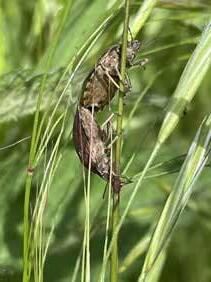
The BioBlitz event was supported by a grant from St. Edmundsbury Town Council and was only possible thanks to the generous efforts of Bury Water Meadows Group volunteers and contributing specialists. It is hoped that similar events will be held again in forthcoming years and will continue to maintain and build interest in the biodiversity living alongside the human residents of Bury’s town centre.
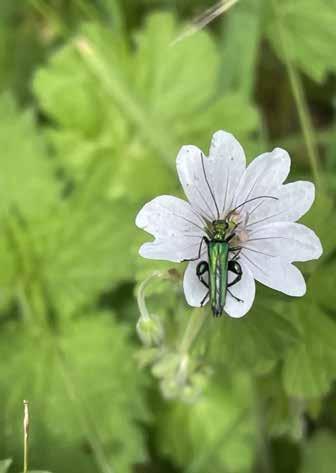
Is your contact information correct?
From time to time, we change email address, or home address and we forget to let others know. If you’ve changed your details recently, please let us know by contacting e enquiries@sns.org.uk
White Admiral 112 1 4
Left: Eurygaster testudinaria by Stephanie Holland
Right: Oedemera nobilis by Stephanie Holland
Adrian Knowles
The first photo here shows two galls on oak – woody structures that have been stimulated to grow by having had gall wasps lay their eggs on or within the twig tissue. The large round “marble gall” was created by the wasp Andricus kollari. Interestingly, the same twig was used by Andricus aries, with the result that two ram’s-horn galls have also formed. These growths protect the eggs and developing larvae of the gall wasp until they eventually mature as adults and break out of their home by biting out a small exit hole – clearly seen on the side of the marble.

For the gall wasp, these growths have done their job, but they are now ready for the lodgers, or ‘successori’ in ecological terms, to move in – solid walls, secure doorway, protection from the elements: who wouldn’t want to live there?! A lot of solitary bees and wasps nest in small cavities in wood, within hollow plant stems or in that fancy “bee hotel” you bought at a garden centre. Disused marble galls are merely bee/wasp ”glamping pods”.
White Admiral 112 1 5
In mainland Europe, it has long been known that the solitary wasp Pemphredon austriaca (family Crabronidae) uses old marble galls as nesting chambers, but they’d never been found in Britain…until 2021. In that spring, Rosie Bleet in Kent “hatched out” several of these wasps that she had been nurturing over the previous winter – the first British examples of this wasp. Having read about these exploits in the newsletter of the Bees, Wasps and Ants Recording Society (BWARS), I thought I should have a go at adding it to the Suffolk list, so in early February I collected a couple of dozen marble galls from the field hedgerows just north of Capel St Mary, whilst out on a regular dog walk. Lo and behold, a month later I, too, discovered P. austriaca in my glass-topped incubators! Thus far, I have provisionally identified 13 P. austriaca.
I say provisionally because these things are awful to identify with certainty. The genus is small in Europe but they have been subjected to a horrible maelstrom of name changes, lumping names together, then splitting them again and some people would probably want to lump back again. Added to this, most of the identification works are in German, adding another layer of complexity to the process. At this point, thanks should be given to Tom Riffel, a former student at the University of Suffolk and friend of a staff member known to David Basham in Ipswich, who, being German (Tom that is), was our man in an hour of need. He has kindly started to translate the German texts on our behalf, even whilst travelling around south America. However, the excitement does not end there. No end of other invertebrates have been emerging from the marble galls, including a few more A. kollari. A few spiders emerged quite quickly. They were probably juveniles that were using the galls as a place of shelter over winter. Likewise, a single weevil, Sitona lineatus, quickly came out to examine the sudden warmth of a heated room. I was surprised to find a couple of tiny bush -cricket nymphs. Presumably these were over-wintering, having hatched out towards the end of 2022 and sought shelter within the galls. A whole range of microscopic parasitic wasps have also appeared. These will have developed at the expense of the eggs or larvae of the original Andricus host or even at the expense of others: parasitoid wasps suffer from parasitoid wasps… Most of these minute parasitoids are beyond my wit and microscope power to identify, but I have had success with one: the Chalcid wasp Bootanomyia (formerly Megastigmus) dorsalis, pictured here. This was identified via an interesting discussion with SNS gall recorder
White Admiral 112 1 6
Most recently, two Rhopalum clavipes have also appeared. These are small solitary crabronid wasps and only the second and third examples of this species I’ve ever seen. They are the first modern records for East Suffolk that I’m aware of, at the time of writing.
I have collected marble galls from three other south Suffolk sites and David Basham is looking after larger numbers in more natural conditions in his shed. These might take longer to reveal their hidden secrets, being kept in cooler conditions.
By the time you receive this newsletter, all these successori insects will be awakening naturally and emerging to go on their way, but next winter why not collect a good handful of marble galls yourself and stay entertained in the dull, wet days of early spring seeing what emerges? Don ’t forget, you’ll need the marbles with a good, healthy hole in them already, which shows that the original host has already evacuated and made way for the next batch of lodgers. Collecting them in January means that the galls should have been exposed to some frost. This cold exposure is needed by some overwintering insects to then trigger final maturation.


Top:
1 7
Jerry Bowdrey and national expert Koorosh McCormack in a Facebook group.
Male Bootanomyia dorsalis
Left: Female Pemphredon austriaca © Jeremy Early
Bob Markham
From Sutton to Butley, slopes and cliffs show glimpses of red amongst the green foliage. This is the Red Crag, a nearly 3 million years old sea bed. In 1915 Clement and Eleanor Mary Reid published their account of the Pliocene flora of the Dutch -Prussian border. The Reuver Clay of that area (dug for tile and pot making) is in part close to our Suffolk Red Crag in age and yielded a rich flora (it is a non-marine deposit).
Barry Hall, with other GeoSuffolk members has planted further Pliocene representative trees, this time on the Red Crag outcrop at a site between Wood Hall and Rockhall Wood SSSI at Sutton (this site is adjacent to a public footpath but some distance from car parking). A new information board, installed in April 2023 (see photo), features Reuver, Orford Coralline Crag and Laurel Forest trees.
What may have been growing here in Red Crag times? Look for the Juglans regia (walnut), Pistacia chinensis (Chinese pistachio) and more. And what animals were living in those forests? Fossils found (but rare) in the Red Crag of Suffolk include tapirs, red pandas and extinct pigs.
The original Pliocene Forest at Sutton
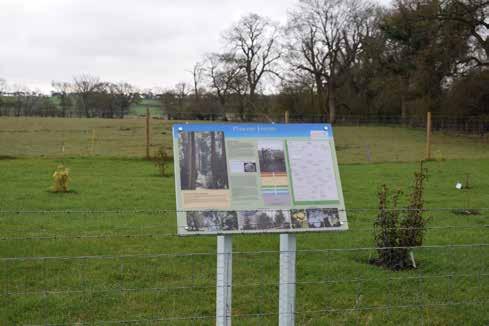
White Admiral 112 1 8
A selection of photos from our new Facebook page
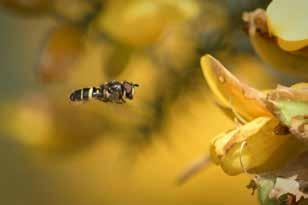


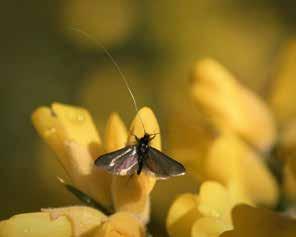

White Admiral 112 1 9
James Corton had a wonderful day at Lound lakes judging by these photos he shared to our Facebook page. Top and top right: A male Dasysyrphus tricintus in. Right: A solitary bee, Andrena sp. Below: A longhorn moth,
Right: Pamela Pope found this beautiful Rhopalid bug Corizus hyoscyami in Lawshall.
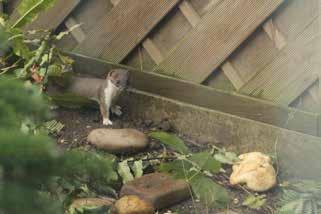


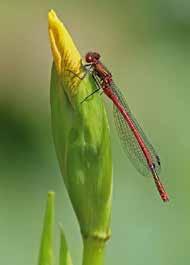

White Admiral 112 2 0
Gemma Louise had an amazing encounter when this Stoat visited her garden Turns out the Stoat had found a rabbit warren and was using Gemma’s garden as the route back to her den to feed her babies.
Large Red Damselfly on Flag Iris from Stewart Belfield.
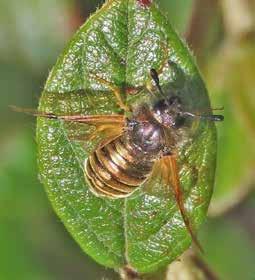
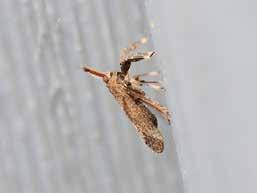
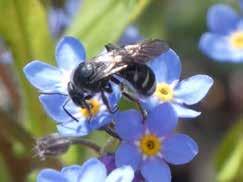
Middle right: Speckled wood, Pararge aegeria. Paul Gilson
Bottom right: Graptus triguttatus weevil, Gary Lowe.
Bottom left: Smooth newt, Lissotriton vulgaris, Chris Cotton.
Middle left: Asiraca clavicornis bug, Joe Myers.



These are just a few of the many posts on our Facebook members page. Unfortunately, we don’t have room to share them all, but please do keep your sightings/photos coming for everyone to enjoy and even learn from.
White Admiral 112 2 1
Top left: Honeysuckle sawfly agg Abia lonicerae/aenea. Pamela Pope.
Top right: Ashy Furrow bee, Lasioglossum sexnotatum. Paul Gilson
Patrick Armstrong
In these pages I drew attention to the life and work of a Suffolk parson-naturalist of episcopal rank. Walter Godfrey Whittingham, MA, DD. FES (1861-1921), Bishop of St Edmundsbury and Ipswich from 1923-1940 (The White Admiral, 106, 107). He had a predecessor who had claims to being both a naturalist and a bishop with strong links to Suffolk: Edward Stanley.
The St Edmundsbury and Ipswich diocese was not separated off from the Diocese of Norwich until 1913, and until then the Bishop of Norwich’s see included Suffolk, with Ipswich; between 1837 and 1849 Edward Stanley, quite a well-known naturalist, held the see of Norwich, comprising both Norfolk and Suffolk. He was a familiar figure throughout both counties, and a friend of the Revd John Henslowbotanist, Charles Darwin ’s friend and mentor, and Rector of Hitcham, Suffolk, for many years.
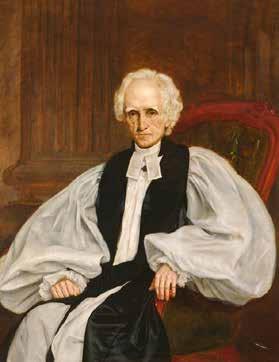
Edward Stanley was born in London on 1st January 1779, the second son (and seventh child) of Sir Thomas Stanley, sixth baronet of Alderley Park, Cheshire, and his wife, née Margaret Owen, who was from a notable Welsh family.
Edward had hoped to enter the Royal Navy, but the family would not countenance this.
He seems to have had a fairly ragged early education, from a
White Admiral 112 2 2
Bishop Edward Stanley, Bishop of Norwich 1837-1849: Ornithologist, Educator, Science administrator, Reformer. By Friedrich Bischoff.
series of private tutors and at small independent schools. He was despatched, in 1798, to St John’s College, Cambridge, arriving, as one obituarist put it ‘knowing nothing of Greek, almost equally ignorant of Latin, and possessing only a smattering of mathematics ’. His diligence seems to have compensated, and in 1802 his name appeared on the list as ‘sixteenth Wrangler’ – sixteenth on the list of those with Honours in Mathematics. He retained an interest in mathematics and statistics throughout his life. Later in the same year he was ordained and served a curacy at Windlesham in Surrey.
In those days it was common for an aristocratic family to own the advowson of one or more parishes: this was the right to appoint the Vicar or Rector of the parish, and the Stanley family had the right of patronage for the living of Alderley, and Edward was appointed in 1805, remaining in post for over 30 years.
By all accounts he was an outstanding priest, championing church schools, temperance organisations and attempting to develop better relations with both Roman Catholics and nonconformists.
Edward had a keen interest in natural history, and indeed science in general, adopting the ‘natural theology’ approach which rejoiced in the living world as part of God’s Creation. He seems to have broad interests in natural history, including entomology, botany, geology and particularly ornithology. His Familiar History of Birds, their Nature, Habits, and Instincts, in two volumes, was published in 1836.
In 1837, Edward Stanley’s predecessor as Bishop of Norwich – since 1805 - a Dr Henry Bathurst, died at the age of ninety-three. Not altogether unsurprisingly the see had been administered with a high degree of laxity for some time. Henry Bathurst had been described as ‘indolent’. Edward Stanley imposed some order: lazy, incompetent priests were removed, and candidates for ordination were thoroughly examined. Schools were built and high educational standards demanded. The new broom was not universally popular, but he developed respect.
White Admiral 112 2 3


Edward married, in 1810 Catherine (Kitty) Leycester, a clergyman ’s daughter. One of their sons served in the Navy, the other was in the Royal Engineers: Edward, having been thwarted in his own naval career indulged his two sons, Owen and Charles. Of the two daughters, Mary, was a great philanthropist, helping poor women; Catherine married the Revd Charles John Vaughan, Headmaster of Harrow School and later Dean of Llandaff.
Edward was, in 1840, elected FRS, but it is as a science administrator that he is best -remembered. He was active in the affairs of the Linnean Society (which he served as President), the Zoology Society of London, the Royal Society and the British Association for the Advancement of Science. He frequently took the chair at meetings of these organisations. He was also a keen supporter of the Ipswich Museum. He was politically active, as a Whig, a reformist, in the House of Lords.
White Admiral 112 2 4
Familiar History of Birds
The Australian National Library contains an extensive correspondence between the Bishop and his naval son Charles. A typical example follows.
Letter from Edward Stanley, Bishop of Norwich to, Captain Owen, Stanley, RN, 29th June, 1848.
I have received the boxes from Sydney, all I conclude from you. 1 containing a pair of Bower birds and [their] twig nest, another of insects and another of birds. I am making a selection for Norwich [and] Ipswich museums ….. Tomorrow evening [there is the ] 2nd Linnean soiree. I sadly miss you in providing materials; my reliance is in fact mainly on the above importations.
Clearly the Bishop used some of his sons’ specimens for some sort of ‘show and tell’ evening at the Linnean Society!
Other correspondence records the arrival at the Bishop ’s Palace in Norwich of specimens of shells, parrots and cockatoos and indeed a whole range of natural history specimens including a ‘possum in a bottle’. Another significant scientific link was with Thomas Huxley, later known as ‘Darwin’s Bulldog’ who served with Charles Stanley on HMS Rattlesnake in Australian, New Zealand and Pacific waters. Bishop Stanley was instrumental in assisting Huxley in securing publication of some of his early papers! This is somewhat ironic, as it was Thomas Huxley who coined the term ‘Agnostic’, and in his desire to professionalise science declaimed that he sought to drive out ‘women, parsons and amateurs’!
The story of Bishop Stanley illustrates several themes in Victorian science and natural history. The influence of William Paley’s Natural Theology (1802), along with Joseph Butler’s Analogy of Religion (1736), persisted: the beauty and complexity of the living world was assumed to provide an insight into the mind of the Creator. There existed a tight network of clergy who were interested in natural history, often linked by kinship and marriage. This was in its turn connected with another network of friends and family members throughout the Empire. Military and naval officers, missionaries and administrators
White Admiral 112 2 5
fed specimens and observations back to naturalists and museums in Britain, to their enormous advantage. The science of the Victorian period – the epoque of Darwin, Huxley, the Hookers, Lyell, Henslow, the Babingtons – and the time of the founding of natural history and other scientific societies and establishment of scientific journals, was greatly strengthened by these social networks.

Biographical Note. Patrick lives in Jolimont, Western Australia, and formerly taught Geography and Ecology at universities and colleges in both the UK and Australia. He has had a long interest in Victorian science. He is the author of The English Parson -Naturalist (Gracewing, 2000).
White Admiral 112 2 6
Catherine (Kitty) Leycester, at about the time of her marriage to Bishop Edward Stanley
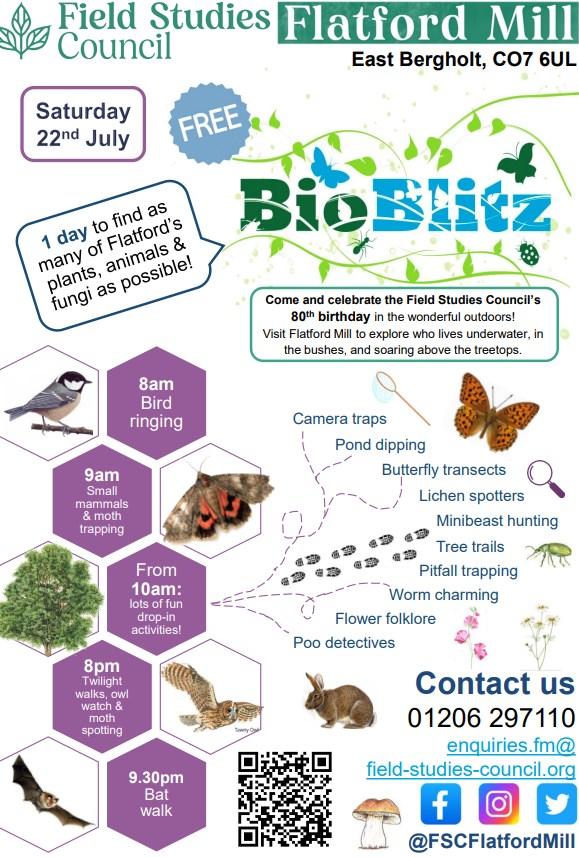
White Admiral 112 2 7
A GRAND DAY OUT
Summer is now here and there’s no better way to get out and record wildlife then actually getting out there and recording wildlife with like minded people!
Here’s a few field trips where everyone with an interest in local natural history is welcome to attend, whether your interest is in lichens, insects, mammals, birds, botany, whatever. Just come along and bring with you a packed lunch, suitable clothing and footwear and the willingness to get involved and meet fellow naturalists.
Lodge Farm
A LEAF Demonstration Farm
Westhorpe, Stowmarket Suffolk. IP14 4TA
Saturday 1st July from 8:30am
This is a farm with arable fields, floral margins, wild flower meadows, scrub, woodland, ponds and a range of Countryside Stewardship scheme options (AB1, AB9, AB8, AB11) plus areas of summer feeding for turtle doves and over two farms . We will be opening the moth traps at 8:30am, however, if you would like to set up a moth trap there and improve coverage over the area, please contact Patrick via
email: patrick@ejbarker.co.uk
There is a toilet block on site
Disclaimer: These are not an organised events and everyone attends at their own risk and the Society will not be held liable for any injuries, damage, etc
White Admiral 112 2 8
SWT Lackford Lakes
Lackford, IP28 6HX
Saturday 15th July
We will have access to parts of the reserve not usually open to the public. A SSSI reserve with new things always being discovered.
Meet in the car park 10:30am (suggested £3 donation for parking)
RSPB Havergate Island
Friday 18th August 9am 2/2:30pm
Quay st, Orford IP12 2NU
Grid Ref: TM425495
Up to 12 people can be ferried across to the island, so if we can have your names first, that would be great. Please let us know by email: whiteadmiralnewsletter@gmail.com
There is a toilet facility on site and a chance to record some wonderful wildlife. Obviously, there are no shops on the island so bring your own packed lunch/refreshments.
The car park is Pay & Display!
Disclaimer: These are not an organised events and everyone attends at their own risk and the Society will not be held liable for any injuries, damage, etc
White Admiral 112 2 9

On behalf of Suffolk Naturalists ’ Council, I would like to provide an and update of changes at SNS and welcome new County Recorders, thank the existing and departing ones for their input.
With the Recorders - Ross Piper has taken over from Howard Mendel who has put in many decades as Coleoptera Recorder. With the Birds Dick Walden, Steve Fryett and Chris Gregory have taken over from Andrew Green, Scott Mayson and Colin Jakes. After stalwart service as Mammal Recorder Simone Bullion hands over to Alison Looser and Sue Hooton is now on the list as Black Poplar Recorder.
On Council we were sad to lose Edward Jackson, Ben Heather (White Admiral) – Hawk Honey has taken on this role as well as SNS ’ Facebook page. While Gen Broad has retired as Secretary she continues managing Grants and Bursaries. Emma Aldous takes on the Website Manager role and Dr. Simon Jackson joins who as Curator at Ipswich Museum provides us with a valuable link. We thank everyone for their time and effort in these roles.
SNS is all about Recording which is vitally important for demonstrating changes in the natural world and while this is becoming increasingly obvious to ordinary people, only pains -taking and on-going record-keeping can establish the true state of species, encourage conservation measures and, importantly, ensure there is a legal framework in place to halt further decline.
SNS is there to support the work of Recorders and will pay certain expenses associated with these activities.
• £50 for an recorder report for publication in Transactions (please apply the Martin Sanford)
• Training for yourself and to run training courses for volunteer recorders.
• Purchasing computer equipment, programmes and training.
• Some other expenses associated with these might be fundable –please contact Martin.
White Admiral 112 3 0
• publishing books or providing financial support towards their production
• There are 6 £500 bursaries for small studies and also grants can be applied for which could be substantial for larger projects. Please visit the SNS website where you can complete an online application form..
Other activities you could try and SNS would support to assist recording, collecting and general networking:
• Holding field meetings – while SNS no longer has an actual field meetings programme these can be promoted in White Admiral and on the website – these can be in the form of ‘Taster days’ for Members to introduce them to Recorders’ studies or bio-blitzes which are currently a popular way of getting records which several SNS Recorders have participated in.
• Use the Society’s publications: the Transactions: Suffolk Natural History for scientific reports and White Admiral for general notes and observations, to inform SNS members of your work and recruit volunteers for surveys etc.
• We hold 2 Members’ evenings one in April (with the AGM) and one November when you are welcome to present reports and promote any survey work you are doing.
• Please make full use of the website (contact Emma Aldous) and the SNS Facebook page - (contact Hawk Honey)
SNS has moved out of Ipswich Museum and is based with Martin Sanford at The Hold in Ipswich.
You would be very welcome to join Council if you have time otherwise we look forward to working with you and perhaps see you at the AGM, Members' evenings or any field meetings.
Joan Hardingham, Chair, SNS

White Admiral 112 3 1
Hawk Honey
One evening just after the sun had set on what had been a warm day, I was clearing up around the garden the various tools such as mower, strimmer, etc and as I walked around the edge of my wildlife pond, I noticed a dragonfly larva a quarter of the way up a flag iris leaf. I knew straight away why this was there and was excited that I was going to see my first ever metamorphosis of a dragonfly. Dragonflies, and damselflies, are unlike other insects in that they do not have a pupal stage in their development. Instead, they go straight from larval stage to adult, a process called metamorphosing.
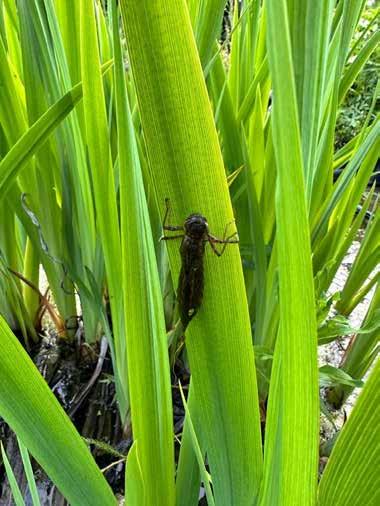
I drew up a stool and positioned myself to watch the process unfurl with camera in hand. Slowly and surely the change began to happen and the exoskeleton began to split open across the thorax. Over the next hour or so, the dragonfly began to emerge and hung backwards from the secured exoskeleton that stayed gripped to the leaf. Each throb of its body edged ever more slowly out.
Then, when it almost seemed to be just a breath away from fully escaping its confines, the process slowed even more and the setting sun was not going to wait any longer. The light began to fade significantly and my aching joints seemed to be thankful that we would have to wait to see if it was still there in the morning, which I feared would



left attached to the leaves as a reminder of what once was. I check everyday now to see what else might be emerging and also look forward to next year as various coupled damsels dance daintily over the water surface depositing their eggs.
As soon as I got up in the morning, I popped out to see if I was going to be lucky enough to observe the end result. I was not disappointed for there she sat, a fully formed Emperor dragonfly (Anax imperator). Her wings were fully inflated and she looked absolutely pristine.
My enjoyment however, did not end there, for over the next few days and nights more and more larvae pulled themselves up from the murky depths and transformed into adults. Total count in the end was 25 empty exuvia (the empty larval case left behind)
Previous page left: The newly emerged larva.
Previous page right: The transformation begins.
Above: Looking vulnerable.
Right: The final product.
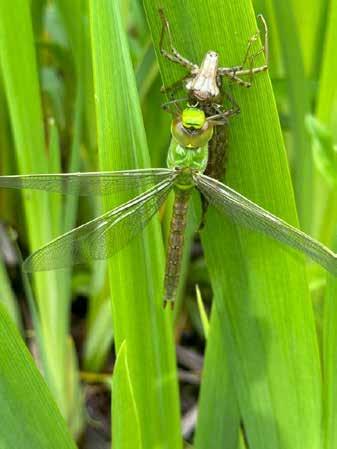
White Admiral 112 3 3
Genevieve Broad
We were delighted to hold our second ‘in person’ event following the Covid restrictions and welcomed 24 people to the Spring Members ’ Evening (and AGM) at Bentley Village Hall on 26th April. Martin started the ball rolling with a snippet about an exciting record from Adam Gretton for the round-mouthed snail Pomatias elegans which was last seen in Suffolk 30 years ago. Found in chalk areas, they are known as ‘land winkles’ as they move differently to other snails. Other intriguing records include three or four Early Spider Orchids from a garden in north Suffolk in 2018; and ten new sites in Suffolk in the last 10 years for Lizard Orchard (a Red Data Book species). The conditions appear to have become favourable as three of these records are from 2022.
House Martins
Martin Tickler gave a fascinating personal account of House Martins, which have sadly seen a 70% decline over the past 50 years. He has observed that the birds take 10 days to build a nest and their first choice is a gable end (and occasionally underneath a board designed to prevent droppings creating a mess below!). However, these boards are often helpful in encouraging people to accept House Martins nesting on their houses.
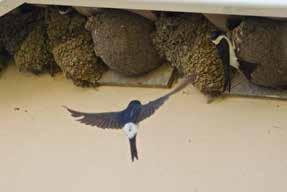
The House Martins arrive in April and breed in May, with the voices of the young changing by Day 24 when they are ready to leave the nest, accompanied by both parents. The nest entrances are very narrow, which appears to be to prevent other males from breaking in during the breeding period. House Martins will travel a few hundred metres to scoop up mud from the edges of ponds for the nests. Interestingly,
White Admiral 112 3 4

Martin has observed juvenile helpers feed a second brood and he has seen fledged House Martins leave the nest to go foraging for the day, returning in the evening.
Many public buildings are suitable for House Martins, such as the water tower at Blythburgh. At a site in Badwell Ash, the developers are adding artificial nests for Swifts, House Martins and bats. Unfortunately, these nests may be hijacked by other birds, such as Blue Tits and House Sparrows, and Gt Spotted Woodpeckers have been known to drill holes in the sides. House Martins will nest on any aspect of the building if the eaves are deep enough to escape the blazing sun. Artificial nests appear to be as successful as natural nests and it ’s not necessary for the nests to be cleaned out.
House Martins are obsessed by white feathers, so Martin adds splashes of white paint - a successful ploy in encouraging House Martins to nest on his house!
Martin Sanford
The new BSBI Atlas published 2020 contains 30 million records and covers the period since the last Suffolk Flora was published (2010 –2019). It comprises two massive volumes which weigh 8.2kg! But the good news is that all of the information is freely available online, including zoomable 10km distribution maps. For the first time, there is a useful analysis of trends and phenology. Martin highlighted the huge amount of effort involved in checking and validating the data. The Atlas is easy to access and to use – the link is https://plantatlas2020.org/
Gen Broad
I’m launching a project to discover what birds mean to people at a personal level and to gather information about Suffolk names for birds. The project is aimed at anyone who feels a connection with birds and I’m intending to share our Suffolk stories through the Ethno-Ornithology World Atlas (https://ewatlas.net/). I became interested after reading an article by Dr Andy Gosler, University of Oxford, in a recent BTO magazine and subsequently discussing a local
White Admiral 112 3 5
project with him. The project is loosely for Suffolk folk, but anyone can take part – all information is valuable. For example, Suffolk names for birds include mollyhawk for Northern Gannet, harnsey for Grey Heron and Seven-coloured finch for Goldfinch. There may be more than one name for a species!
The survey is extremely short and simple, comprising only four questions - What's your favourite bird and why? Do you know of any local Suffolk names for birds? Or from any other counties? And finally, please tell me any of your favourite stories about birds. They don ’t have to be local. For example, I co -led an expedition in the Philippines which discovered a new species of bird (the Calayan Rail) and so this would obviously be my own bird story! But my favourite bird is the Kingfisher as this links to fond childhood memories.
The survey is on a Google form so it can be filled in online and will automatically be returned to me when the sender clicks ‘submit’. Alternatively, I would be happy to send the form in hard copy or by email to anyone who doesn’t want to engage with Google technology! Please get in touch genevieve.broad@outlook.com
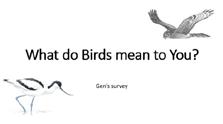
Autumn Members Evening
Our next members evening will be on Thursday 16th November
Venue: TBC
There will be a table there for your natural history curiosities so please bring them along. Every day’s a school day.
White Admiral 112 3 6










